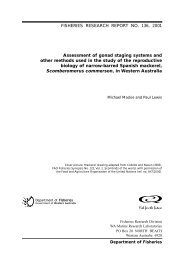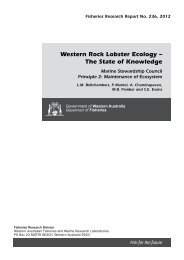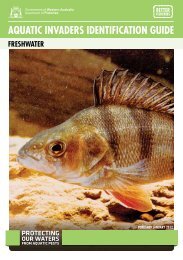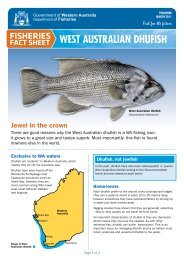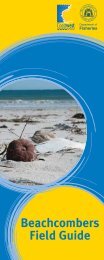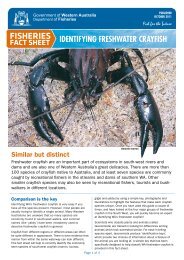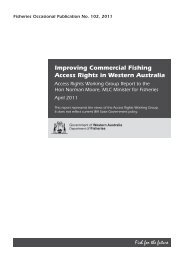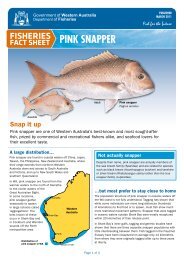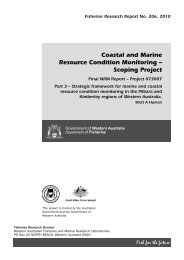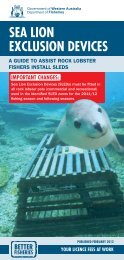DEPARTMENT OF FISHERIES ANNUAL REPORT TO THE ...
DEPARTMENT OF FISHERIES ANNUAL REPORT TO THE ...
DEPARTMENT OF FISHERIES ANNUAL REPORT TO THE ...
You also want an ePaper? Increase the reach of your titles
YUMPU automatically turns print PDFs into web optimized ePapers that Google loves.
AgENCy PERFORMANCE � CASE STUDy 2<br />
Hi-tech tagging helps manage Cockburn<br />
Sound snapper stocks<br />
Department of Fisheries research carried out in<br />
Cockburn Sound during 2010/11 has used high<br />
technology acoustic tags to track the movements of<br />
pink snapper to and from the area. Cockburn Sound<br />
is the only significant spawning area for pink snapper<br />
in the West Coast Bioregion – the stretch of coast<br />
running from east of Augusta to the Zuytdorp Cliffs,<br />
north of Kalbarri.<br />
Every year, some time between August<br />
and December, thousands of adult pink snapper<br />
congregate in Cockburn Sound to release their eggs<br />
and sperm, as part of what are known as ‘spawning<br />
aggregations’. As a result, there is an annual seasonal<br />
Fisheries researcher with a pink snapper (Inset: pink snapper<br />
with tags near dorsal fin).<br />
86<br />
closure to pink snapper fishing in the area (extended<br />
as part of a package of management changes in<br />
2005), which runs from October 1 to December 15 to<br />
protect these spawning fish.<br />
Fish that join the spawning aggregation in<br />
Cockburn Sound reach sexual maturity when they<br />
are about six years old and 600 mm in length.<br />
These fish are much larger relative to those from<br />
other areas in the West Coast Bioregion – which<br />
means they can produce relatively larger numbers of<br />
eggs – and are thus very important for pink snapper<br />
stocks in the entire bioregion.<br />
The Department of Fisheries has been<br />
conducting surveys since 2001 to estimate<br />
the spawning biomass of snapper that form<br />
the aggregations in Cockburn Sound each year.<br />
Preliminary estimates suggest the biomass was<br />
declining prior to the management changes in 2005,<br />
but has subsequently increased as the result of<br />
factors such as changing the timing and extending<br />
the length of the closure from six to ten weeks, and<br />
adjusting the daily bag limit so that a maximum of<br />
one fish over 70 cm in length could be taken.<br />
Other factors that have helped to increase<br />
the spawning biomass include an influx of mature<br />
pink snapper into the Cockburn Sound spawning<br />
population from the strong stock recruitment that<br />
occurred in 1999.



